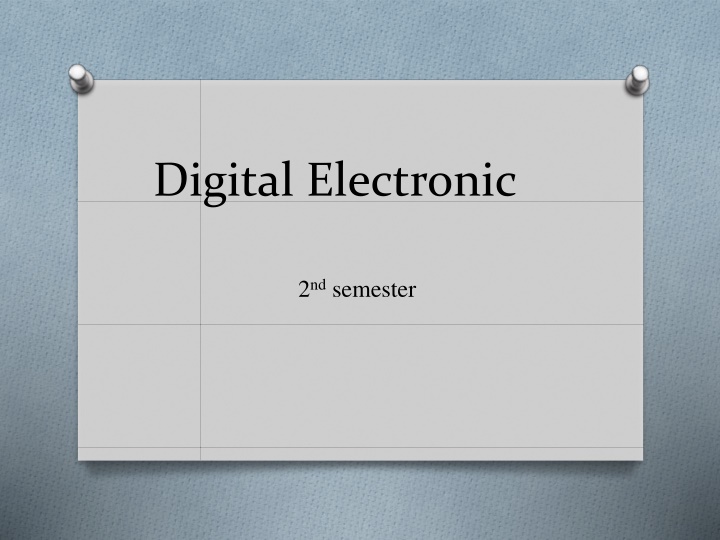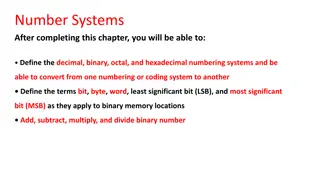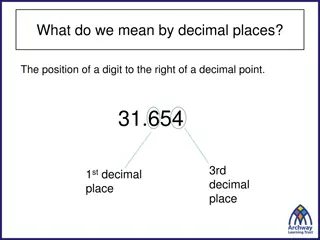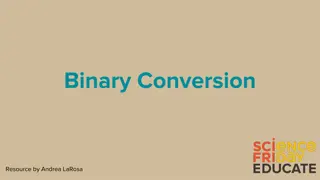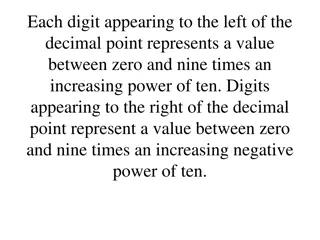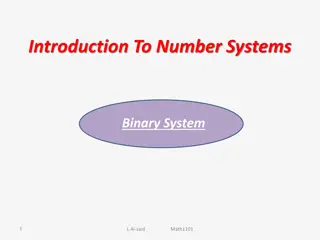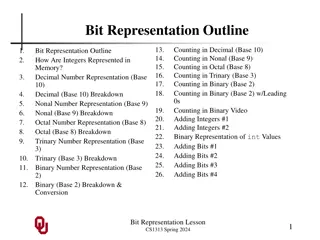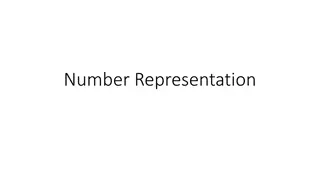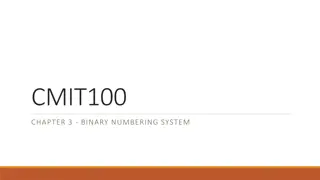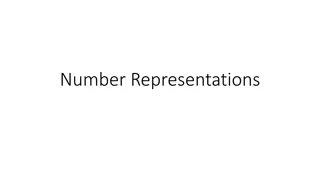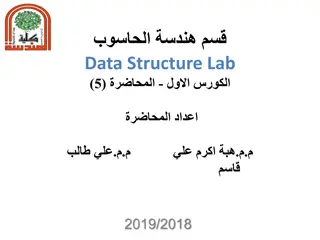Conversion from Decimal Numeration to Binary, Octal, Hexadecimal
In digital electronic studies, understanding the conversion from decimal numeration to binary, octal, and hexadecimal systems is crucial for computer science enthusiasts. This process involves repeated cycles of divisions to break down the decimal number into binary, octal, or hexadecimal place weight values. Learn how to convert decimal numbers to binary using division principles and explore examples of converting numbers less than 1 to binary. Dive into exercises to practice converting decimal numbers to binary effectively.
Download Presentation

Please find below an Image/Link to download the presentation.
The content on the website is provided AS IS for your information and personal use only. It may not be sold, licensed, or shared on other websites without obtaining consent from the author.If you encounter any issues during the download, it is possible that the publisher has removed the file from their server.
You are allowed to download the files provided on this website for personal or commercial use, subject to the condition that they are used lawfully. All files are the property of their respective owners.
The content on the website is provided AS IS for your information and personal use only. It may not be sold, licensed, or shared on other websites without obtaining consent from the author.
E N D
Presentation Transcript
Digital Electronic 2ndsemester
Chapter One Lecture 4 2
1.4.2 Conversion from decimal numeration system to others systems: The conversion from decimal numeration system to others systems of numeration is an important task for everyone dealing with computer science, because it permits to move from daily world to digital world. To convert a number from decimal numeration system to binary, octal or hexadecimal, we use repeated cycles of divisions to break the decimal numeration down into multiples of binary, octal or hexadecimal place weight values. In the first cycle of division, we take the original decimal number and divide it by the base of the numeration system that we are converting to: It meant that for binary, we should divide by 2, for octal we should divide by 8, for hexadecimal we should divide by 16. Then we take the whole number portion of the division result and divide it by the result again, and so on, until we end up with a quotient of less than the base value. 3
Decimal to binary conversion: Let us convert the decimal number 8710 to binary, using the principle described above. It meant that the decimal number should be repeatedly divided by 2. 4
The coloured ciphers are the reminders of repeated division of the decimal number by 2. To obtain the binary number, we just have to take those reminders, beginning with the last one, as indicated by the arrow. Then we have: In short, the binary bits are assembled from the reminders of the successive division steps, beginning with the LSB (Least Significant Bit) and proceeding to the MSB (Most significant Bit). 5
Exercise 1.5: Convert the following decimal numbers to binary A = 15310 B = 25510 C = 4610 D = 3810 6
Conversion of decimal numbers less than 1 to binary: For converting a decimal number less than 1 to binary. we use repeated multiplication by 2, taking the integer portion of the product in each step as the next digit of our converted number. Let us convert the decimal number 0.37510 to binary: Each step gives us the next bit further away from the binary point, so the binary number is obtained taking the bits from up to down. 7
Remark 1.3: With integer division, worked from the LSB to the MSB (down to up) But with repeated multiplication, we worked from up to down. Exercise 1.6: Convert from decimal to binary: A = 0.812510 B= 0.62510 C = 0.87510 D = 0.4062510 8
Remark 1.4: To convert a decimal number greater than 1 with a less than 1 component, we should use both techniques, one at time. Let us convert the decimal number Step one: repeated division for the integer portion to binary. 9
Let us convert the decimal number Step one: repeated division for the integer portion to binary. 10
Exercise 1.7: Convert from decimal to binary A = 17.37510 B = 43.62510 C = 27.87510 D = 49.4062510 11
1.4.2.3 Decimal to octal conversion: Let us convert the number numeration system. As explained before, we just have to divide the decimal number successively by 8. from decimal to octal The octal digits are determined by the reminders left over by each division step. These reminders are between 0 and 7. 12
Exercise 1.8: Convert the following numbers from decimal to octal: A = 32310 B = 45210 C = 12810 D = 9910 13
1.4.2.4 Decimal to hexadecimal conversion: Let us convert the number from decimal to hexadecimal. This conversion is obtained by repeated division of the decimal number by 16. 14
Exercise 1.9: Convert from decimal to hexadecimal: A = 452310 B = 86710 C = 99710 D = 123810 15
